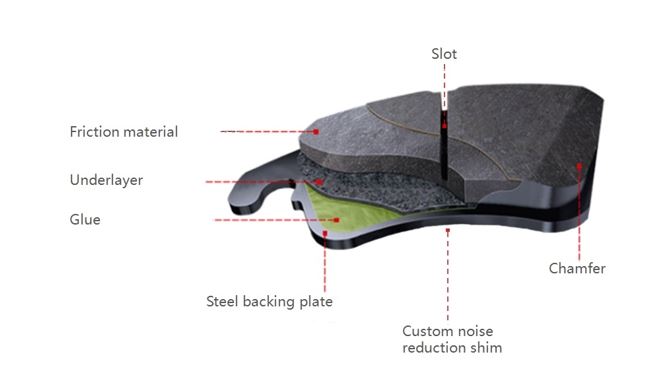Components of a Brake Disc:
- Friction Material:
The friction material is environmentally-friendly and 100% asbestos and copper-free. Using the latest technology, this friction material has been developed for optimal braking and quick response in all driving conditions. - Under Layer:
The under layer, between the backing plate and friction material, is designed to absorb and dissipate the vibration which often causes braking noise. - Glue:
Extremely high-quality glue is used for optimal shear strength, providing confidence in every braking application. - Steel Backing Plate:
High quality steel is used to prevent the backing plate from bending under pressure. - Noise Reduction Shim:
This not only reduces brake noise, but also adds ultra comfort with every braking application. - Chamfer:
These are placed on the leading and trailing ends of the pads to reduce noise when brakes are applied. - Slot:
The groove in the pads provides a passage for gases and dust to escape during high brake temperatures. The slot also works as a stress release to prevent the pad from cracking when brake pressure is applied.
What Make Deselra Different?
Deselra Brake Pads are manufactured using a considerably softer compound than other brands. A softer compound helps with noise reduction (squeal) and ensures less wear on the brake disc (rotor). Deselra Brake Pads also give a softer pedal feel when braking.
E-Mark Certification
All Deselra Brake Pads are E-Mark approved. This is a quality certification for motor vehicle safety parts and is derived from regulations issued by the Economic Commission of Europe (ECE). After testing has been carried out on the pads, they are marked with the R90 code number, as well as the country code, in a circle. This signifies where the testing was done: (E1) will signify that the testing was carried out in Germany. Given that Grandmark’s Deselra Brake Pads carry the E-Mark certification, we trust that they are equal to, or better in quality than, the OE pads.
How Often Should Brake Pads Be Replaced?
Brake pads must be replaced as soon as the friction material has worn down to 2mm, or when the pads show signs of uneven wear.
Brake pads consist of two main parts: the backing plate and the friction material. Some brake pads are fitted with wear indicators and/or wear sensors. These sensors alert the driver when the brake pads fitted to the vehicle are worn and need to be replaced. This alert is either a flashing, notification light on the dashboard or a screeching sound coming from the brake disc.
Both front and rear callipers should be replaced simultaneously in order to prevent uneven braking. Both callipers must be properly cleaned and inspected to ensure that the backing plate moves freely in the calliper.
PLEASE NOTE: using any oil-based products to clean the callipers is not advised. Doing so will greatly impact the performance of the brake pads.
Also view:
Brakes, Braking and Road Safety
